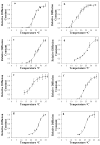The alpha,alpha-(1-->1) linkage of trehalose is key to anhydrobiotic preservation
- PMID: 17676844
- PMCID: PMC2551324
- DOI: 10.1021/ja0731266
The alpha,alpha-(1-->1) linkage of trehalose is key to anhydrobiotic preservation
Abstract
This study compares the efficacy of six disaccharides and glucose for the preservation of solid supported lipid bilayers (SLBs) upon exposure to air. Disaccharide molecules containing an alpha,alpha-(1-->1) linkage, such as alpha,alpha-trehalose and alpha,alpha-galacto-trehalose, were found to be effective at retaining bilayer structure in the absence of water. These sugars are known to crystallize in a clam shell conformation. Other saccharides, which are found to crystallize in more open structures, did not preserve the SLB structure during the drying process. These included the nonreducing sugar, sucrose, as well as maltose, lactose, and the monosaccharide, glucose. In fact, even close analogs to alpha,alpha-trehalose, such as alpha,beta-trehalose, which connects its glucopyranose rings via a (1-->1) linkage in an axial, equatorial fashion, permitted nearly complete delamination and destruction of supported bilayers upon exposure to air. Lipids with covalently attached sugar molecules such as ganglioside GM1, lactosyl phosphatidylethanolamine, and glucosylcerebroside were also ineffective at preserving bilayer structure. The liquid crystalline-to-gel phase transition temperature of supported phospholipid bilayers was tested in the presence of sugars in a final set of experiments. Only alpha,alpha-trehalose and alpha,alpha-galacto-trehalose depressed the phase transition temperature, whereas the introduction of other sugar molecules into the bulk solution caused the phase transition temperature of the bilayer to increase. These results point to the importance of the axial-axial linkage of disaccharides for preserving SLB structure.
Figures








Similar articles
-
Molecular simulation study of phospholipid bilayers and insights of the interactions with disaccharides.Biophys J. 2003 Nov;85(5):2830-44. doi: 10.1016/s0006-3495(03)74706-7. Biophys J. 2003. PMID: 14581188 Free PMC article.
-
Interaction of the sugars trehalose, maltose and glucose with a phospholipid bilayer: a comparative molecular dynamics study.J Phys Chem B. 2006 Aug 10;110(31):15572-81. doi: 10.1021/jp060789l. J Phys Chem B. 2006. PMID: 16884281
-
Interaction of the disaccharides trehalose and gentiobiose with lipid bilayers: a comparative molecular dynamics study.J Mol Graph Model. 2010 Nov;29(3):331-46. doi: 10.1016/j.jmgm.2010.09.013. Epub 2010 Oct 8. J Mol Graph Model. 2010. PMID: 21115286
-
Thermodynamic, hydration and structural characteristics of alpha,alpha-trehalose.Front Biosci (Landmark Ed). 2009 Jan 1;14(9):3523-35. doi: 10.2741/3468. Front Biosci (Landmark Ed). 2009. PMID: 19273290 Review.
-
Stabilization effects of saccharides in protein formulations: A review of sucrose, trehalose, cyclodextrins and dextrans.Eur J Pharm Sci. 2024 Jan 1;192:106625. doi: 10.1016/j.ejps.2023.106625. Epub 2023 Nov 2. Eur J Pharm Sci. 2024. PMID: 37918545 Review.
Cited by
-
A review of artificial sebum formulations, their compositions, uses and physicochemical characteristics.Int J Cosmet Sci. 2025 Feb;47(1):168-189. doi: 10.1111/ics.13022. Epub 2024 Sep 9. Int J Cosmet Sci. 2025. PMID: 39246274 Free PMC article. Review.
-
Air-stable supported membranes for single-cell cytometry on PDMS microchips.Lab Chip. 2010 Apr 7;10(7):864-70. doi: 10.1039/b921817c. Epub 2010 Jan 11. Lab Chip. 2010. PMID: 20300673 Free PMC article.
-
Cryopreservation of Human Adipose Tissues and Adipose-Derived Stem Cells with DMSO and/or Trehalose: A Systematic Review.Cells. 2021 Jul 20;10(7):1837. doi: 10.3390/cells10071837. Cells. 2021. PMID: 34360005 Free PMC article.
-
Fluidic and air-stable supported lipid bilayer and cell-mimicking microarrays.J Am Chem Soc. 2008 May 14;130(19):6267-71. doi: 10.1021/ja800049f. Epub 2008 Apr 12. J Am Chem Soc. 2008. PMID: 18407640 Free PMC article.
-
Role of trehalose in heat and desiccation tolerance in the soil bacterium Rhizobium etli.BMC Microbiol. 2012 Sep 17;12:207. doi: 10.1186/1471-2180-12-207. BMC Microbiol. 2012. PMID: 22985230 Free PMC article.
References
-
- Crowe JHCJS. Anhydrobiosis. Dowden, Hutchinson & Ross; Stroudsburg, PA: 1973.
-
- Crowe JH, Crowe LM, Chapman D. Science. 1984;223:701–703. - PubMed
-
- Crowe JH, Crowe LM, Oliver AE, Tsvetkova N, Wolkers W, Tablin F. Cryobiology. 2001;43:89–105. - PubMed
-
- Sussman AS, Lingappa BT. Science. 1959;130:1343–1343. - PubMed
Publication types
MeSH terms
Substances
Grants and funding
LinkOut - more resources
Full Text Sources
Other Literature Sources

